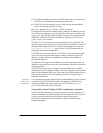
120 Intel NetStructure Cache Appliance Administrator’s Guide
The following table lists the HTTP caching directives that the appliance follows.
Transparent proxy caching
In nontransparent proxy caching, client browsers must be configured to send Web
requests to the Intel NetStructure Cache Appliance proxy. Many sites have no
direct control over user browser settings, making it necessary for site
administrators to tell users to configure their browsers to direct requests to the
proxy.
Transparency solves this problem. The transparency option enables the appliance
to respond to Internet requests without requiring users to reconfigure their
browser settings. It does this by redirecting the traffic flow into the cache after it
has been intercepted by an L4 switch or router.
This section provides the following:
✔ An overview of how the appliance serves requests transparently. See Serving
requests transparently‚ on page 121.
✔ A discussion of interception strategies supported by the Intel NetWorking
Cache Appliance. See Interception strategies‚ on page 121.
Directive source Caching directives
administration
options
❚ Don’t cache objects with URL addresses containing ?,
;, /cgi or end in .asp.
❚ Don’t cache objects served in response to the Cookie:
header.
❚ Set never-cache rules from the command-line
interface. Refer to Configuring caching rules‚ on
page 79.
client Don’t cache objects with the following request headers.
You can override some of these directives using
administration options.
❚ Cache-Control: no-store header
❚ Cookie: header
❚ Authorization: header
Web server Don’t cache objects with the following response headers.
You can override some of these directives using
administration options.
❚ Cache-Control: no-store
❚ www-Authenticate: header
❚ Set-Cookie: header
❚ Cache-Control: no-cache header
❚ Pragma: no-cache header
❚ Expires: header with value of 0 (zero) or a past date


















